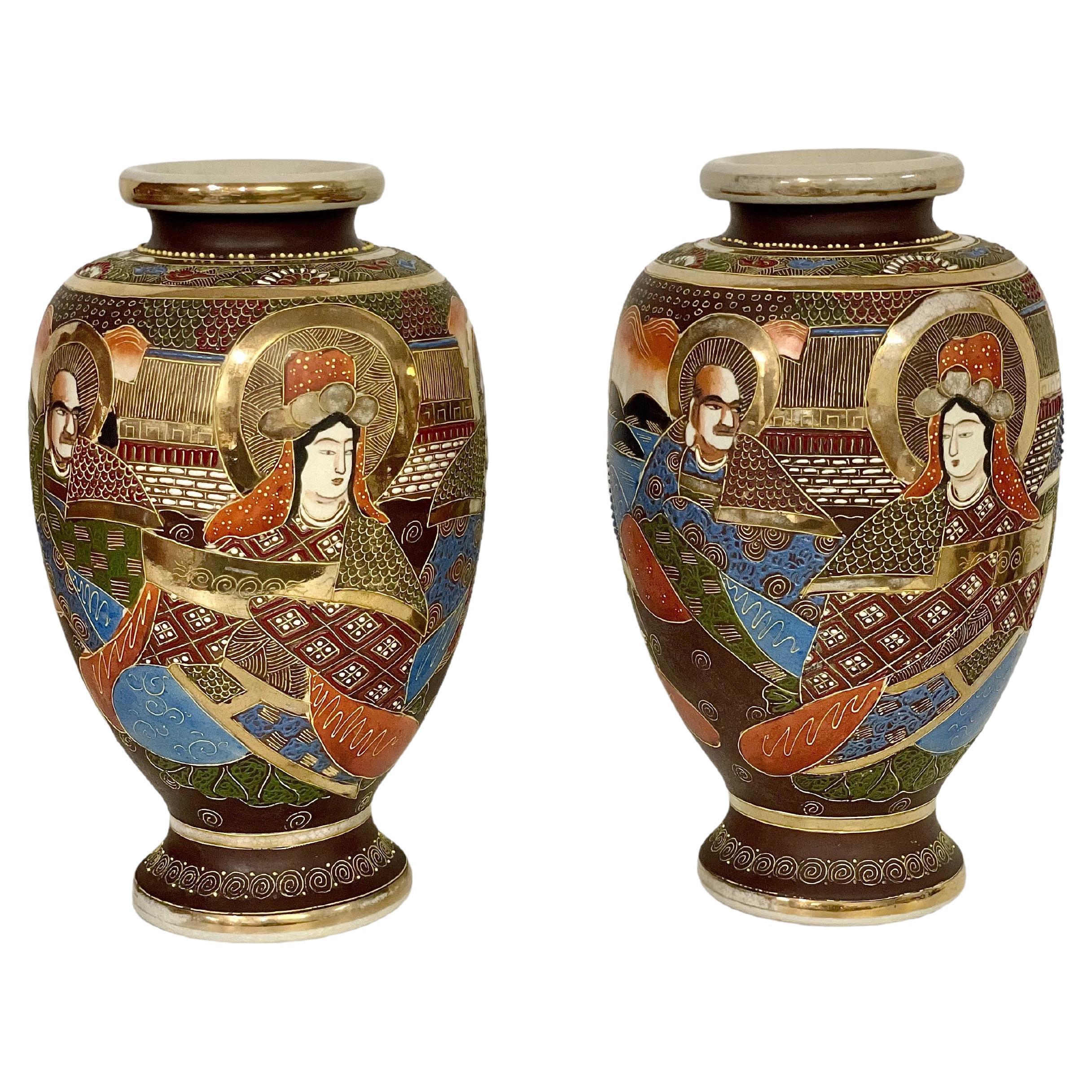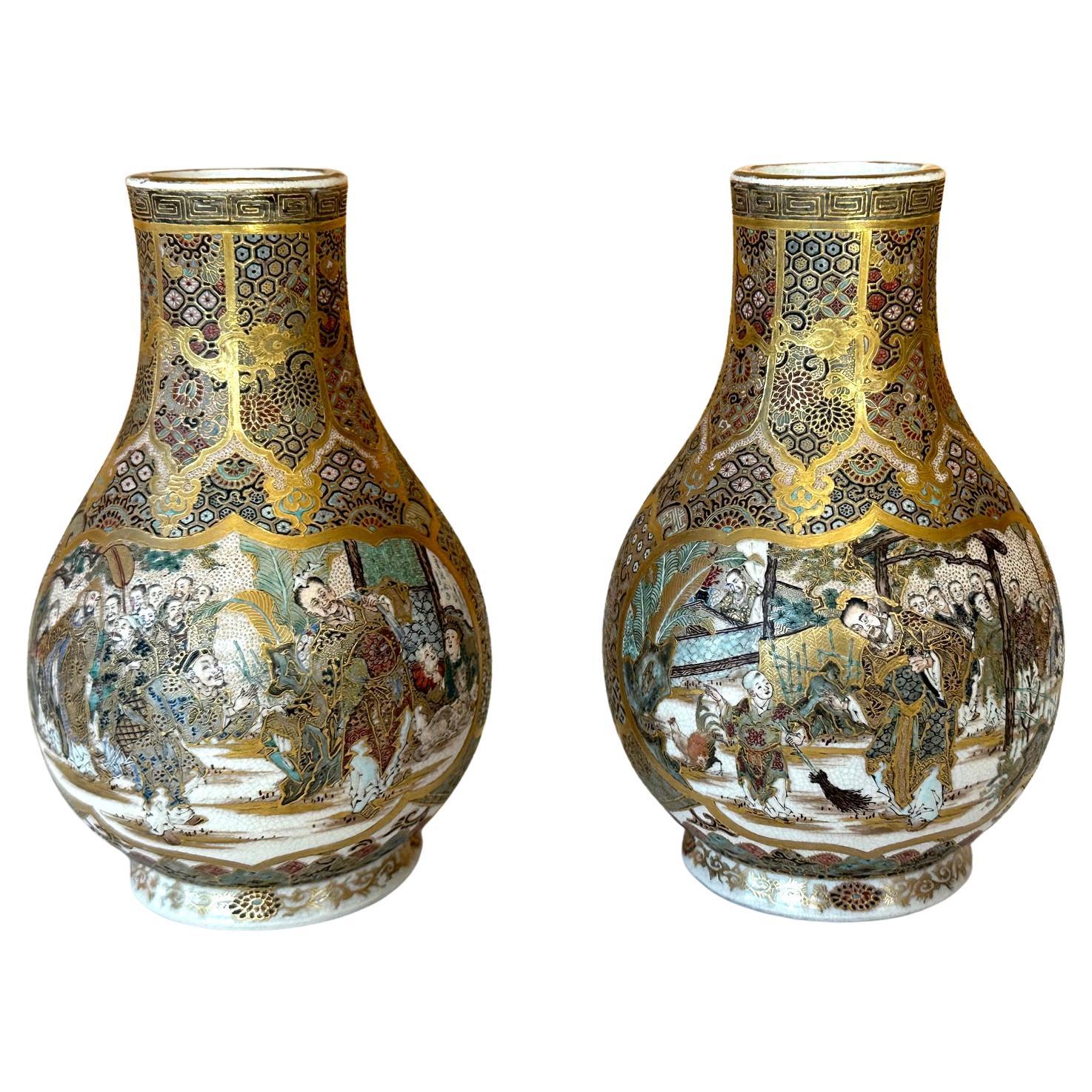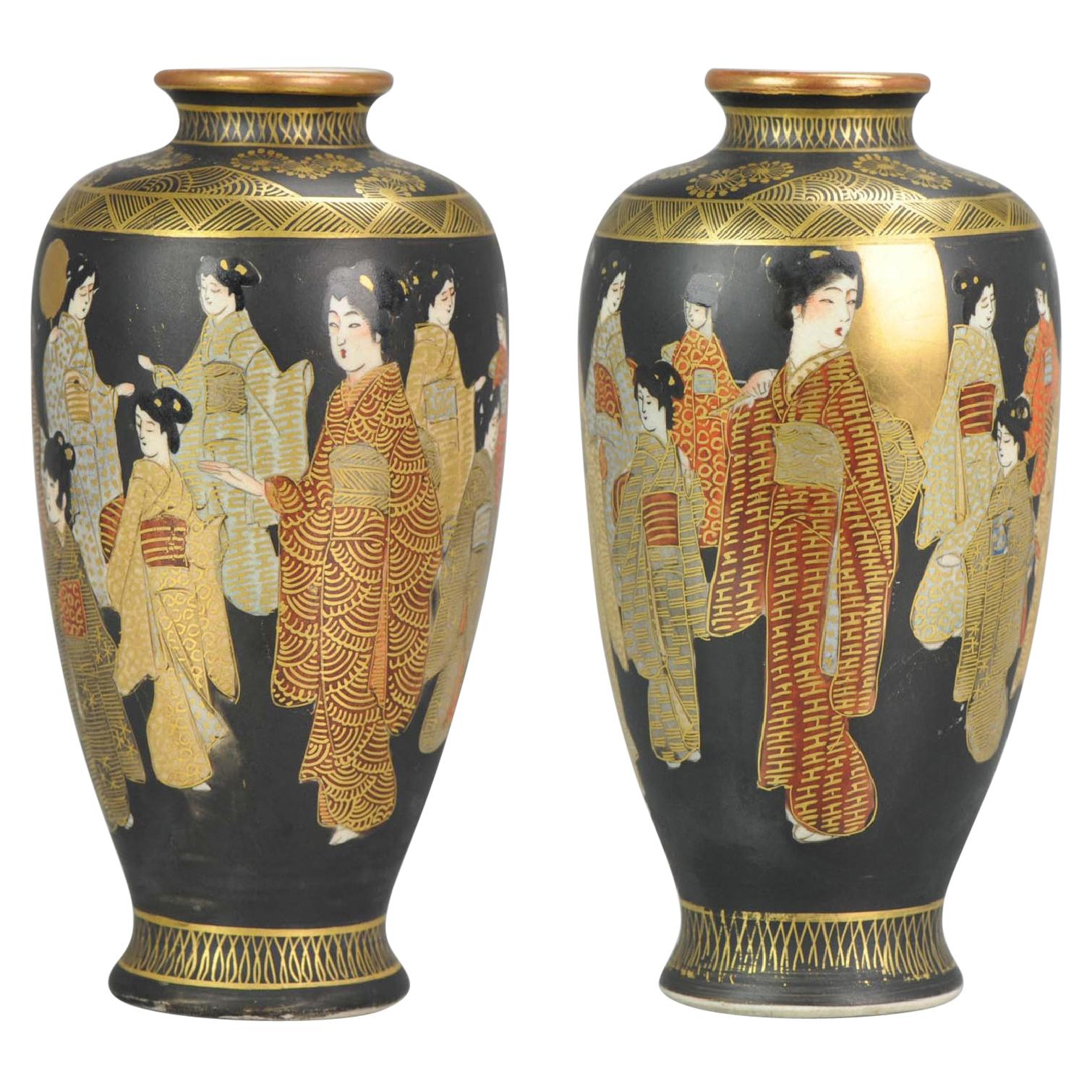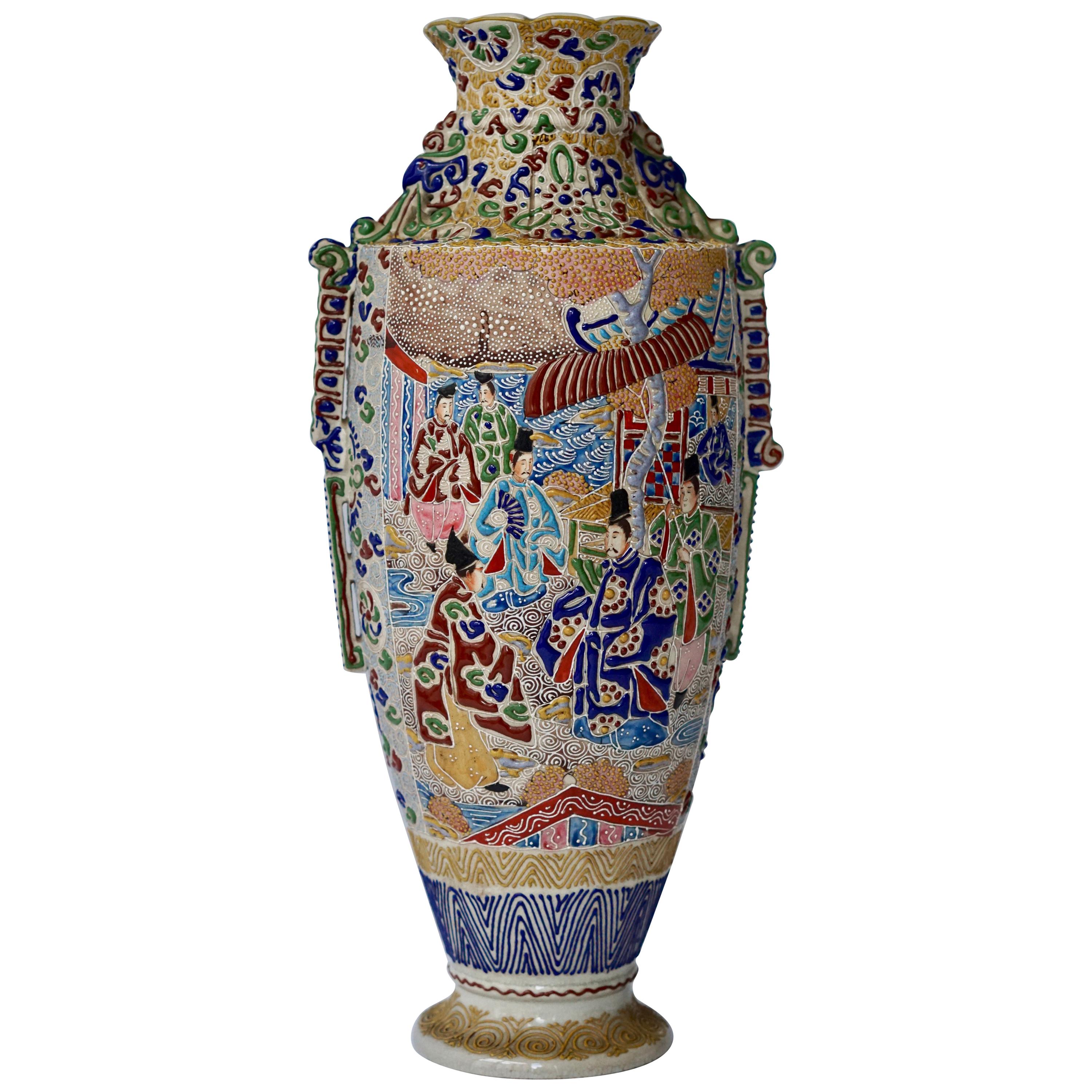Items Similar to Pair of Japanese Moriage Satsuma Vases with Gold Gilding Circa 1930-1940
Video Loading
Want more images or videos?
Request additional images or videos from the seller
1 of 19
Pair of Japanese Moriage Satsuma Vases with Gold Gilding Circa 1930-1940
About the Item
Japanese Satsuma vases from the circa 1930-1940 period are a particular style of ceramic art that originated from the Satsuma province of Japan. Satsuma ware is renowned for its intricate hand-painted designs, rich colors, and distinctive crackled glaze.
Satsuma ware dates back to the early 17th century, but it gained widespread popularity in the late 19th and early 20th centuries, including the 1930s and 1940s. Satsuma vases produced during this time often reflected a mix of traditional and modern influences, as Japan went through a period of cultural exchange and artistic experimentation.
Satsuma vases are made from a type of Japanese earthenware clay known for its fine texture and malleability. The vases are hand-formed or wheel-thrown and then meticulously hand-painted with intricate designs using enamel paints. The distinctive crackled glaze was achieved by firing the vases at a relatively low temperature, allowing the glaze to crack during the cooling process.
The moriage technique involves applying three-dimensional, raised ornamentation to the surface of the ceramic piece, creating a visually textured and layered effect. Artisans create three-dimensional patterns, designs, or intricate motifs using a special mixture of clay, slip, or porcelain paste. The raised elements are added by hand to the ceramic body, and each detail is carefully shaped to achieve the desired effect.
The moriage is then gold gilded as some of the intricate ornamental patterns and the halos around the three immortal figures depicted on each vase. The decoration is of Kannon with a rakan on each side of her. In Buddhist iconography, Kannon (also known as Kuan Yin or Avalokiteshvara) is a Bodhisattva associated with compassion and mercy. Bodhisattvas are enlightened beings who have chosen to postpone their own enlightenment to help alleviate the suffering of all sentient beings. The imagery of Kannon flanked by a rakan on each side is a common representation in Buddhist art, especially in Japan. The rakan are individuals who have attained a high level of spiritual realization and enlightenment. They are considered disciples of the Buddha and are revered for their wisdom and guidance on the path to enlightenment. The composition of Kannon with a rakan on each side emphasizes the interconnectedness of compassion, wisdom, and enlightenment.
The other side depicts a priest in front of a temple, with the Kunlun mountains depicted in the background – where all immortals reside.
Mark attributed to late Showa or Taisho period
- Dimensions:Height: 12.8 in (32.5 cm)Diameter: 7.29 in (18.5 cm)
- Sold As:Set of 2
- Style:Showa (Of the Period)
- Materials and Techniques:
- Place of Origin:
- Period:
- Date of Manufacture:1930-1940
- Condition:Wear consistent with age and use.
- Seller Location:Ixelles, BE
- Reference Number:1stDibs: LU8924235547102
About the Seller
No Reviews Yet
Vetted Seller
These experienced sellers undergo a comprehensive evaluation by our team of in-house experts.
1stDibs seller since 2023
Typical response time: 1 to 2 days
- ShippingRetrieving quote...Ships From: Ixelles, Belgium
- Return PolicyA return for this item may be initiated within 14 days of delivery.
More From This SellerView All
- Pair of 19th Century Qing Dynasty Faux Bamboo Chinese VasesLocated in Ixelles, BEFaux bamboo Chinese vases were a type of decorative art that emerged during the Qing Dynasty (1644-1912) in China. These porcelain vases were designed to mimic the appearance of bamboo, a plant highly regarded in Chinese culture for its resilience, elegance, and symbolism. Bamboo is associated with attributes such as flexibility, strength, and modesty, making it a popular motif in Chinese art. In the Qing Dynasty the color yellow held significant symbolism and represented imperial authority, power, and the emperor himself. Yellow was considered the most sacred and prestigious color in Chinese culture, and it had strong associations with the emperor's position as the Son of Heaven and the ruler of all under heaven. The marks at the bottom of the vases indicate that these were crafted more specifically during the Tongzhi period – an emperor who reigned from 1861 to 1875, which effectively lasted nthrough his adolescence and was largly overshadowed by the rule of his mother, Empress Dowager Cixi. Although he had little influence over state affairs, the events of his reign gave rise to what historians call the “Tongzhi Restoration”, an unsuccessful modernization program. The polychrome enamels representing on one vase a traditional Chinese kite...Category
Antique Late 19th Century Chinese Chinese Export Ceramics
MaterialsPorcelain
- Pair of Late 19th Century Cantonese Famille Rose Vases in PorcelainLocated in Ixelles, BEFamille Rose refers to a type of Chinese porcelain characterized by the use of opaque, brightly colored enamels, prominently featuring shades of pink, purple, green, and yellow. The ...Category
Antique Late 19th Century Chinese Chinese Export Ceramics
MaterialsPorcelain
- Large Pair of Graduated Turquoise Porcelain Foo Dogs. Chinese Circa 1880Located in Ixelles, BEChinese turquoise-colored porcelain foo dogs from circa 1880 are exquisite examples of traditional Chinese ceramic art. Foo dogs, also known as guardian lions or temple lions, are ic...Category
Antique Late 19th Century Chinese Qing Ceramics
MaterialsCeramic
- 19th Century Chinese Nankin Porcelain VaseLocated in Ixelles, BENanjing Porcelain, also known as Nanking Porcelain and referred to as "Nanjing" by Western dealers in the 19th century, was a type of Chinese porcela...Category
Antique 19th Century Chinese Chinese Export Ceramics
MaterialsPorcelain
- Pair of Moon-Shaped Vases, China Late 19th CenturyLocated in Ixelles, BEA pair of large moon-shaped "flasks" vases painted in blue and white, each flask decorated with scenes of active characters and surrounded by borders of floral motifs and foliate pat...Category
Antique Late 19th Century Chinese Antiquities
MaterialsPorcelain
- Antoine Giroux Fauvist Painting - Still Life with Fruit - Ref 238By Antoine GirouxLocated in Ixelles, BEAntoine Giroux: Capturing the Vibrancy of the Mediterranean Born in Brussels in 1955, Antoine Giroux's journey to artistic expression took a unique path through the realms of music ...Category
Late 20th Century Belgian Modern Paintings
MaterialsWood, Paint
You May Also Like
- Pair of Japanese Satsuma 'Moriage' Porcelain Gilt VasesBy SatsumaLocated in LA CIOTAT, FRThis handsome pair of 20th century glazed and gilded Japanese Satsuma vases, with their vivid, jewel-like colours and elegant baluster-shaped forms, feature the traditional Japanese ...Category
20th Century Japanese Ceramics
MaterialsPorcelain
- Pair of Fine Miniature Satsuma Vase with Moriage Enamel Decoration by SeikozanLocated in Atlanta, GAA pair of small ceramic vases with superb surface decorations made by Japanese studio Seikozan circa 1890-1910s (late Meiji Period). One of the many artist studios that specialized i...Category
Antique 1890s Japanese Meiji Ceramics
MaterialsCeramic
- Large 1900-1930 Satsuma Antique Garniture Japanese Colorful Vases, JapanLocated in Amsterdam, Noord HollandGreat pieces, nice interior addition. Condition Biggest vase both lid and vase were restored, foot also. Small vases in good condition, only a chip to nose of one of the dogs. ...Category
20th Century Chinese Showa Ceramics
MaterialsPorcelain
- Pair of Antique Japanese Satsuma Vase Japanese Satsuma Ware Lovely LadiesLocated in Amsterdam, Noord HollandFabulous Japanese vases with an all around scene of lovely ladies, 19th century. Marked at base, ?? Yasui Condition Overall condition vase 1 perfect, just some minimal enamel...Category
Antique 19th Century Japanese Meiji Ceramics
MaterialsEarthenware
- Moriage Nippon Vase, Japanese PorcelainLocated in Hamilton, OntarioBeautiful Japanese Moriage vase, late 19th century-early 20th century. Free shipping within the United States and Canada.Category
Early 20th Century Japanese Vases
MaterialsPorcelain
- Japanese Satsuma Vase with FiguresLocated in Antwerp, BEA mid-20th century Japanese Satsuma vase with figures. Satsuma ware is a style of Japanese earthenware originally from the Satsuma region of what is today southern Kyushu. There are two distinct categories of this ware: The original plain dark clay early Satsuma...Category
Mid-20th Century Japanese Japonisme Vases
MaterialsCeramic
Recently Viewed
View AllMore Ways To Browse
Vase With Gold
Antique Gilding
Gold Gilding
1930 Japan
Pottery Made In Japan
Asian Vase Gold
Japanese Earthenware
Gold Ware
Satsuma Vases
Antique Asian Gold Vase
Antique Satsuma Vase
Satsuma Vase Antique
Antique Japanese Pottery And Ceramics
Pair Of Asian Figures
Antique Japanese Earthenware
Japanese Crackle
Temple Japanese Buddhist
Antique Glaze Lowes





